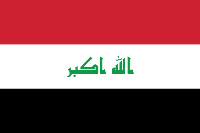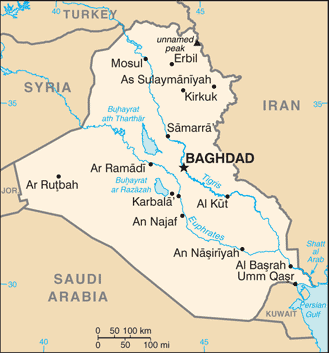Oct 3 2012
Topics Covered
Welcome to Iraq
Overview of Resources
Industrial Minerals
Metals
Fossil Fuels
Investment
Sources
Welcome to Iraq
Iraq, with a total population of 31,129,225 as of July 2012, is located in the Middle East, bordering the Persian Gulf, between Iran and Kuwait. The country mostly has a desert climate and covers a total area of 438,317 km2.
 |
The national flag of Iraq.
Image Credit: CIA Factbook. |
It was in 1932 that Iraq as a kingdom gained its independence and in 1958 a republic was proclaimed. Iraq owns the second largest crude oil reserves in the world and the country’s economy is mostly dominated by the oil sector. Iraq’s oil sector provides more than 90% of government revenue and 80% of foreign exchange profits.
In 2011, the government saw an increase in its revenue due to the global increase in oil prices and the country’s GDP as of 2011 was $129.3 billion.
Overview of Resources
The key natural resources in Iraq include natural gas, petroleum, sulfur and phosphates.
In 2010, Iraq was globally considered as the 11th largest producer of crude oil whose production averaged about 2.5 Mbbl/d and accounted for 3.1% of the crude oil output in the world. Between 2009 and 2010, the exports of crude oil in the country averaged 1.9 Mbbl/d and during this period Iraq was one of the leading oil exporting countries in the world.
In 2010, Iraq had significant reserves of gravel, sandstone and standard sand. Besides being a chief producer of natural gas and crude oil, the country also produced small quantities of sulfur, cement, bauxite, clays, limestone, gypsum, bentonite, salt and kaolin.
Industrial Minerals
In 2010, Iraq was a leading cement importer in the Middle East. Several investors were invited by the Ministry of Industry and Minerals (MIM) to develop five cement plants in the country in order to use the numerous limestone reserves available in Iraq. Investors were attracted by the low production cost, wide spread of raw materials and increasing local market demand.
The Paleocene Akashat Formation in Iraq’s Western desert is known for its phosphate rock deposits. In 2010, companies were invited by the MIM to invest in the extraction and concentration of these deposits in collaboration with the General Company for Phosphates.
Silica sand deposits, at Iraq’s Al-Anbar Governorate, had the capacity to produce 150,000 t/yr at a cost of $4 to $6 million. The MIM in 2010 invited companies to invest in the mining of these silica deposits.
In 2010, 153,000 Mt of ammonia and 210,000 t of urea were produced by Iraq’s State Company for Fertilizers. Companies were invited to invest in three newly constructed urea plants located in the Governorates of Nineveh, Basrah and Al-Anbar.
Metals
In 2010, a memorandum was signed by the MIM with STX Heavy Industries Co. Ltd. of the Republic of Korea along with an unnamed Turkish partner in order to redevelop the Iraq’s Iron and Steel State Co. steel complex at Khawr az Zubayr in the Basrah Governorate. Through this project, the country had plans of producing 1.2 Mt/yr of iron bar, 1.2 Mt/yr of hot-rolled products and 600,000 Mt/yr of section steel.
Iraq has a number of significant diamond and gold reserves and the country hopes to increase its production of gold.

The map of Iraq. Image Credit: CIA Factbook
Fossil Fuels
In 2010, the natural gas production in Iraq’s South Gas Project was expected to reach 70.8 million m3 per day. This project involved the capturing, treating and processing of natural gas for domestic usage and exporting trade.
Iraq’s oil refining capacity, in 2010, increased by 12.2% to 856,000 bbl/d from 763,000 bbl/d in 2009. The output of petroleum products saw an increase by 12.4% to 513,200 bbl/d in 2010 from 456,600 bbl/d in 2009. In October 2010, Iraq’s proved crude oil reserves increased by 24% to 143.1 Gbbl from the 2001 estimates of 115 Gbbl.
In 2010, operation at Iraq’s largest oilfield called the Rumaila, started as a joint venture between BP p.l.c. of the United Kingdom and China National Petroleum Corp. in 2010, the country planned to build four new refineries at Nassiriyah, Kerbala, Missan and Kirkuk apart from increasing its refining capacity to 1.5 Mbbl/d by 2017.
Investment
Iraq’s 2012 budget forecasts oil exports of 2.6 bbl/day that will result in an increase from the country’s average of 2.2 bbl/day in 2011. The country aims at upgrading its export, oil processing and pipeline infrastructure to attract foreign investments. Such improvements are of urgent significance as Iraq still experiences an unstable political and security system, corruption, insufficient essential services, antiquated commercial laws and outdated infrastructure. Solving these issues will indeed give way for more investments and speed up the growth of the country’s non-oil and private sectors.
Iraq is thus planning to introduce a new set of laws that will establish a modern legal framework for the oil sector and also develop a mechanism for equal distribution of oil revenues within the nation.
The country hopes to expand its mineral industry in the near future and further enhance the supply of its commodities for the country’s reconstruction projects and infrastructure. The country’s production of natural gas and crude oil is also likely to increase through the enrollment of foreign oil companies in the development of the country’s hydrocarbon resources.
The production of crude oil, cement, phosphate, sulfur and phosphate rock are also expected to see an increase in the future in order to satisfy the domestic demand for the country’s mineral commodities.
Experts feel that it is high time the country shifted its focus onto the mining of commodities such as copper, iron, marble and phosphate that are available in plenty in Iraq’s Kurdistan region. Mining of these commodities will indeed boost the country’s economy that totally depends on its oil sector.
With increase in the production of mineral commodities, development of new mining projects, attracting foreign investments, implementing new reforms and uprooting corruption, Iraq thus hopes to see a positive change in its mining sector in the near future.
Disclaimer: The Author of this article does not imply any investment recommendation and some content is speculative in nature. The Author is not affiliated in any way with any companies mentioned and all statistical information is publically available.
Sources